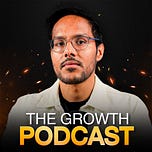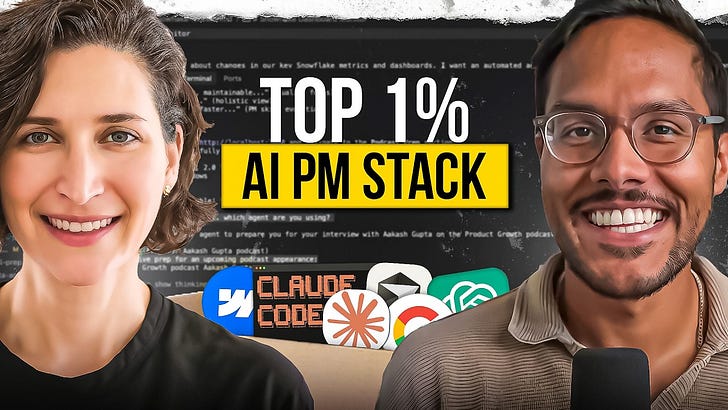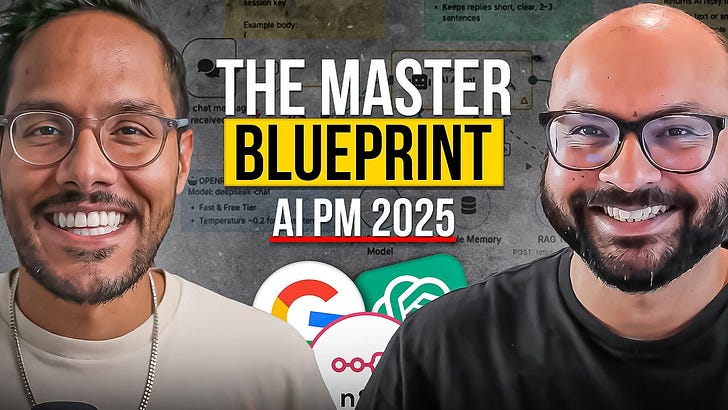Check it out on Apple, Spotify, or YouTube.
And thanks to our sponsors:
Amplitude: Try their 2-minute assessment of your company’s digital maturity
Product Faculty: Get $500 off the AI PM certification with code AAKASH25
Today’s Episode
We have the VP of PM of an $11.7B company.
And we’re using the time with him well.
We cover:
A live demo of building an AI agent with Airtable
How Airtable grew to such a valuation
How Airtable builds product
If you’re a PM or product leader looking to improve, this episode is for you.
Some of My Favorite Takeaways
1. 6 Ways Airtable Can Automate Your PM workflow
In our live cooking session, we demoed specific ways PMs and product teams are using Airtable AI to streamline their work:
Auto-triage product feedback so you’re not buried in scattered comments.
Aggregate and summarize user interviews from tools like Zoom or Gong.
Track competitors with automated monitoring, no manual research needed.
Build a connected research repository that turns transcripts into insights.
Identify beta users by querying customer data with natural language.
Use CoBuilder, just describe what you need, and it builds it.
You can automate other tasks too like drafting PRDs, coordinating launches, or distributing insights across teams.
2. The Best PMs at Airtable Think in Systems
Anthony doesn’t hire PMs just because they’re sharp or “shippable.”
He looks for people who understand how models, logic, and abstraction create leverage.
The strongest PMs at Airtable:
Think deeply about how data moves through the system
Understand when to hide complexity vs. expose it
Design for builders and operators, not just users
Can lead cross-functional teams without playing traffic cop
If you want to build tools that other people build on top of…
Product judgment isn’t optional. It’s foundational.
3. How Airtable Builds Products: Model-First
He shares that everything great about the Airtable experience…
Comes from a strong data model and permissioning layer, not flashy polish.
This matters when you’re building for both technical and non-technical users.
Airtable’s team constantly balances:
→ How much to abstract
→ When to offer smart defaults
→ How to progressively reveal power as users grow
If the model is wrong, no amount of UI can save the experience.
4. Advice For PMs Who Wants To Build Great Products
Zoom out. Then zoom in with intention.
If you want to build durable, flexible systems so you can build great products, do this:
Start by building a mental model: what is the product really doing under the hood
Map the edges of flexibility. Where do users get lost? Where do they break things
Think in abstractions, but ground those abstractions in real use cases
Don't build for the UI. Build for evolution.
The systems that last aren't just usable, they’re adaptable by everyone.
5. Big Lessons from Airtable’s evolution
Flexibility is powerful until it paralyzes!
Early Airtable was a builder’s dream: you could create almost anything.
But he shares that this freedom came at a price, people didn’t know where to start.
Here’s how Airtable evolved:
– Added stronger defaults so teams didn’t start from a blank slate
– Built templates and opinionated UIs to steer users toward best practices
– Invested in tools like Product Central to show how internal teams use Airtable at scale
The big shift? they started designing for clarity and adoption and not for flexibility.
Because when everything is possible, nothing feels obvious :)
Where to Find Anthony
If you prefer to only get newsletter emails, unsubscribe from podcast emails here.
If you want to advertise in the podcast, email productgrowthppp at gmail.
Up Next
I hope you enjoyed the last episode with David Pereira (where we discussed why most managers are bullish*t managers). Up next, we have episodes with:
Dr. Bart Jaworski - Senior PM, 125K+ on LinkedIn
Spenser Skates - CEO and Founder, Amplitude
Pawel Huryn - 190K+ on LinkedIn, Fmr CPO
Finally, check out my latest deep dive if you haven’t yet: How to Build a Scaled Experimentation Engine.
Cheers,
Aakash











